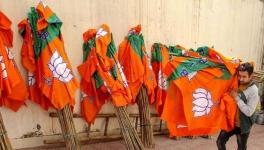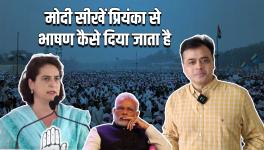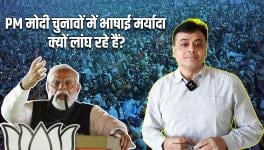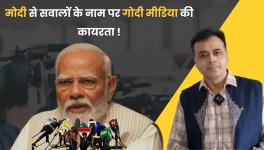Lok Sabha Elections: Can INDIA Bloc Do it in Delhi?

Lok Sabha elections 2024 are taking place in a political environment that is different from 2019 in a number of ways.
First, most of the key Opposition parties have constituted themselves into an Indian National Developmental Inclusive Alliance (INDIA). In Delhi, the Aam Aadmi Party (AAP) and Indian National Congress (INC), the two principal INDIA bloc partners as far as Delhi is concerned, are contesting four and three Lok Sabha seats, respectively. The other parties in the INDIA bloc, as well as social organisations, have commenced their support campaign in all seven constituencies. Polling will be held on May 25.
Second, the Bharatiya Janata Party (BJP) has no overwhelming campaign issue that can override all others to result in a wave election. Instead, the entire 10-year record of the BJP government at the Centre is being subject to intense critical scrutiny.
Nevertheless, the neo-fascist dispensation is trying to continuously rake up communal fervour based on their persistent communalisation of society, especially in Delhi. The INDIA bloc partners need to be alert and prevent the election in Delhi from being communalised. They can do this by firmly orienting the election campaign around livelihood issues. Let us see how.
To begin with, the BJP government at the Centre has been working non-stop to stymie the functioning of the AAP-led Delhi government. This has been persisted with through adverse executive intervention in spite of judicial verdicts to the contrary. This first reveals the adverse posture of the neo-fascist dispensation toward federalism. But it also is motivated by the intention to create public disaffection towards the Delhi government due to its ostensible non-performance.
Further, as part of the political offensive against opposition leaders, the Chief Minister of Delhi and some other ministers have been arrested on charges that have not led to any conviction. This has also happened in the case of other court proceedings and detention against all other Opposition leaders and activists.
The detentions seem to be intended to create an ostensible equivalence between the corruption allegations against the neo-fascist dispensation (including the electoral bonds imbroglio where there has been no legal follow-up and innumerable instances of the most extreme types of crony capitalism) on the one hand, and the cases against the Opposition leaders on the other.
Besides, these cases against the Opposition party leaders may have been foisted with the intention of foiling the organisational integrity of opposition parties. But this has not happened in Delhi after the arrest of the Chief Minister. Instead, there has been a groundswell of support for Opposition leaders in Delhi who have been questionably incarcerated.
Besides these broad political issues that are relevant in Delhi, there are other livelihood issues that are relevant to the voters in Delhi. Let us briefly discuss some of those issues.
First, macroeconomic data reflect increasing socio-economic inequalities. The inequality and wealth inequalities in India are possibly among the highest at the global level, with 40% of total national wealth and 23% of national income, respectively, owned/claimed by top 1% of the population during 2022.
Second, unemployment has affected all age groups: from 10% (for age 15-29) to 42.3% (for graduates under age 25) to 9.8 % (for graduates of age 30-34). Under the BJP government, the Indian economy has transitioned from jobless growth to job-loss growth. Here jobless growth refers to the non-rise in organised sector jobs while job-loss growth refers to fall in employment rate in both the organised and unorganised sectors.
Women have been disproportionately affected by unemployment, as manifested by the historic lows to which rates of paid labour force participation has plunged in India. The BJP government at the Centre has responded to the pressing problem of unemployment in a manner that is unbecoming of any administration: abandoning labour force surveys, distorting data and making believe that the problem of unemployment is non-existent.
Before turning to the election manifesto promises of the Indian National Congress, let us briefly examine the policy orientation of the Delhi government. A simple graph allows a distinction that can be made between the policy orientation of the BJP Union government and the AAP-led Delhi government.
From Figure 1, it is possible to glean that the percentage shares of expenditures on education, health and social welfare are significantly higher in Delhi government’s budget when compared to the Union government in 2024-25. The share of education in Delhi government’s expenditure is 21.57%, while that of the Central government is 2.62%.
Similarly, the share of Delhi government’s health expenditure is also higher at 11.43% in comparison to that of the Union government’s share of 1.89%. Likewise, the share of social welfare expenditure of Delhi government is 8.18%, as compared to the Union government’s share at 1.19%. Even after accounting for the fact that 13% of the Union government’s budget is allocated to defence, the neglect of basic needs by the Centre since 2014 is completely transparent.
This broad policy orientation of the Delhi government is manifested in specific policies, such as the enhancements in school education, advancement in healthcare, budget support for power, water distribution and transport of women etc.
Keeping in mind the broad policy orientation of the Delhi government, let us next consider some key manifesto promises of the Congree that concern workers, farmers, women, Dalits and tribals namely:
-
Provision of 30 lakh new government permanent jobs: this will be an essential break with the neo-liberal project’s trajectory since 1991.
-
Employment Guarantee Act will be extended to urban areas: this will provide a floor level of income to working people and this labour may be expended in areas where supply bottlenecks impinge.
-
Ensuring Rs. 400 per day as minimum wage for the workers: this too will ensure a floor-level of income for workers and will work better when implemented along with the employment guarantee.
-
Life insurance and accident insurance for unorganised workers: this would be a much needed measure given the sordid record of safety at workplaces, especially in the unorganised sector,
-
Stop contractualisation of employment in core government functions: this would be an important move for not only enhancing the rights of workers but also improving the reach and quality of functioning of the government.
-
Rs. 1 lakh per annum for educated Indian youths to undertake apprenticeship in the Indian labour market: this would not only be a social security measure but also hasten the attenuation of mismatches between composition of labour demand and the existing skills of workers.
-
Better social security and working conditions for gig economy workers: this is an urgent measure, since such workers currently labour under the most appalling work conditions under the veneer of ostensible glitter of the platform economy.
-
Legal guarantee for minimum support prices for agricultural produce: this would not only provide a floor level of income for Indian farmers including those in Delhi but also expand the cultivation of crops like lentils (dal) which is currently lagging demand.
-
Loan waver scheme for Indian farmers: this has become necessary due to aggravation of India’s policy induced agrarian crisis.
-
Guaranteed insurance payment within 30 days of crop loss to farmers: this will be a relevant measure since the corporate financial oligarchy is actively shifting the burden of crop failure on to the farmers themselves by denying them insurance coverage under various pretexts for further corporate encroachment into peasant agriculture.
-
Stable import-export policy to benefit farmers: this ought to ensure that corporate agribusiness does not dump imported agricultural produce in the country.
-
No more Goods and Service Tax (GST) on inputs for farming: This will damp down the continuous increase in the cost of cultivation
-
Rs. 1 lakh per annum for 1 Indian woman in poor families: this measure will provide a floor level of income and consumption to working women while the resultant derived demand will increase all round employment in the economy.
-
50% women reservation in new Central government jobs: this measure will work to counter the falling paid labour force participation of women and the consequent gender skew in the composition of employment especially in the organised sector.
-
Double salary contribution of centre for all ASHA, Anganwadi, and Mid-Day Meal workers: this measure would not only enhance the quality of public services but also work to undermine the scandal whereby the government itself violates its labour laws when it comes to ASHA workers.
-
Adhikar Maitri in every village, to ensure women get their legal rights: this measure will enable women to combat gender injustice but this will work better when other measures of women’s empowerment, discussed in previous points, are put in place.
-
Double number of hostels for working women: this measure will work to reduce the decline in paid labour force participation of women.
-
Promise of caste census: this measure will uncover the realities of social injustice in India thereby enabling the formulation of suitable policies.
-
50% cap on SC/ST/OBC reservation will be removed by a constitutional Amendment: this measure is necessary to make the economy and polity more representative of the social composition of the people of India.
-
Special Budget for SC/ST, equal to their share in population: this measure will enable to some extent the translation of policies for social justice into funded programmes.
The INDIA bloc has a clear set of policies that could address the livelihood problems of the people of Delhi people, including inequality, unemployment and inflation. These policies can be gleaned from the record of the Delhi government, the election manifesto of the Congress and the policies and practices of other partners of the INDIA bloc we have pointed out in a synoptic form.
There remains, however, the political-organisational domain of fighting elections in Delhi for the INDIA bloc. This will require at least three factors to operate:
First, marginalisation of the communal agenda of BJP by keeping the campaign focus on livelihood issues; Second, on the ground unity between AAP and Congress to effectively deal with the organisational stature of BJP; Third, making the INDIA bloc campaign in Delhi broad-based by involving all like-minded organisations.
The INDIA bloc supported by the mass movements is capable of doing it in Delhi in Lok Sabha elections 2024.
Narender Thakur is professor, Department of Economics, BR Ambedkar College, University of Delhi. C. Saratchand is professor, Department of Economics, Satyawati College, University of Delhi. The views are personal.
Get the latest reports & analysis with people's perspective on Protests, movements & deep analytical videos, discussions of the current affairs in your Telegram app. Subscribe to NewsClick's Telegram channel & get Real-Time updates on stories, as they get published on our website.
























